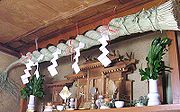
Kamidana
Encyclopedia

Shinto
or Shintoism, also kami-no-michi, is the indigenous spirituality of Japan and the Japanese people. It is a set of practices, to be carried out diligently, to establish a connection between present day Japan and its ancient past. Shinto practices were first recorded and codified in the written...
-style ceremonies, the most prominent of which is the shintai
Shintai
In Shinto, , or when the honorific prefix go- is used, are physical objects worshiped at or near Shinto shrines as repositories in which spirits or kami reside...
, most commonly in the form of a small circular mirror, though it may also take the form of a stone (magatama
Magatama
Magatama , are curved beads which first appeared in Japan during the Jōmon period.They are often found inhumed in mounded tumulus graves as offerings to deities . They continued to be popular with the ruling elites throughout the Kofun Period of Japan, and are often romanticised as indicative of...
), jewel, or some other object with largely symbolic value. A similar shrine, when placed at ground-level upon a platform possessing three or four steps, is referred to as a kamidoko. Worship at the kamidana typically consists of the offering of simple prayers, food (e.g., rice, fruit, water) and flowers. Before worshiping at the kamidana it is ritually important for family members to cleanse their hands.
Kamidana can also be found in some traditional Japanese martial art dōjō
Dojo
A is a Japanese term which literally means "place of the way". Initially, dōjōs were adjunct to temples. The term can refer to a formal training place for any of the Japanese do arts but typically it is considered the formal gathering place for students of any Japanese martial arts style to...
. The word is frequently confused with Kamiza
Kamiza
is the Japanese language term referring to the "top seat" within a room, meaning the place of honor; the term also applies to the best seats in air-planes, trains, and cars. The antonym, meaning "bottom seat," is shimoza...
(上座), the seat of a honor in a room or dojo, but without any connection to Shinto.
See also
- Spirit houseSpirit houseA spirit house or san phra phum is a shrine to the protective spirit of a place that are found in the Southeast Asian countries of Burma, Cambodia, Laos, and Thailand. Most houses and businesses have a spirit house placed in an auspicious spot, most often in a corner of the property. The...
- ButsudanButsudanA butsudan is a shrine commonly found in temples and homes in Japanese Buddhist cultures. A butsudan is a wooden cabinet with doors that enclose and protect a gohonzon or religious icon, typically a statue or painting of a Buddha or Bodhisattva, or a "script" mandala scroll...
- Etiquette in Japan

